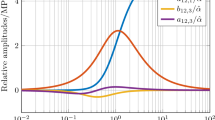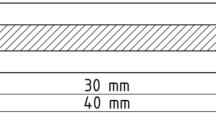Abstract
Elastomers have wide and ever increasing applications in several industries. In this work a compressible visco-hyperelastic approach is employed to investigate the behavior of elastomeric materials. The time-discrete form of the material model is developed to be used in numerical simulations. This formulation provides a recursive relation to update the stress in any time step regarding the deformation history. By means of analytical solutions derived for pure torsion of a solid circular cylinder, the numerical implementation is validated and then, the response of an elastomeric bushing is investigated in torsional, axial and combined deformations. These bushings are used in suspension systems to reduce amplitude of vibrations as well as shocks. It is shown that, the numerical model well simulates the non-linear time dependent response of the bushing in different deformation rates. Also, a multi-step relaxation test is simulated to identify the hysteretic behavior. Finally, fully relaxed response of the bushing for torsional and combined torsional–axial deformations is predicted and compared with those of experiment as well as three other constitutive models. The comparisons reveal that, the proposed approach well predicts the coupling effect of axial displacement on torsional moment where it is not the case for other compared models.















Similar content being viewed by others
References
Aniskevich, K., Starkova, O., Jansons, J., Aniskevich, A.: Viscoelastic properties of a silica-filled styrene–butadiene rubber under uniaxial tension. Mech. Compos. Mater. 46, 375–386 (2010)
Arruda, E.M., Boyce, M.C.: A three-dimensional constitutive model for the large stretch behavior of rubber elastic materials. J. Mech. Phys. Solids 41(2), 389–412 (1993)
Bechir, H., Chevalier, L., Chaouche, M., Boufala, K.: Hyperelastic constitutive model for rubber-like materials based on the first Seth strain measures invariant. Eur. J. Mech. A Solids 25(1), 110–124 (2006)
Bergström, J.S., Boyce, M.C.: Constitutive modeling of the large strain time-dependent behavior of elastomers. J. Mech. Phys. Solids 46(5), 931–954 (1998)
Brinson, H.F., Brinson, L.C.: Polymer engineering science and viscoelasticity: an introduction. Springer, New York (2008)
Darijani, H., Naghdabadi, R., Kargarnovin, M.H.: Constitutive modeling of rubberlike materials based on consistent strain energy density functions. Polym. Eng. Sci. 50(5), 1058–1066 (2010)
Diani, J., Brieu, M., Gilormini, P.: Observation and modeling of the anisotropic visco-hyperelastic behavior of a rubberlike material. Int. J. Solids Struct. 43(10), 3044–3056 (2006)
Doll, S., Schweizerhof, K.: On the development of volumetric strain energy functions. J. Appl. Mech. 67(1), 17–21 (2000)
Drozdov, A., Kalamkarov, A.: A constitutive model for nonlinear viscoelastic behavior of polymers. Polym. Eng. Sci. 36(14), 1907–1919 (1996)
Gent, A.: A new constitutive relation for rubber. Rubber Chem. Technol. 69, 59–61 (1996)
Hoger, A.: A second order constitutive theory for hyperelastic materials. Int. J. Solids Struct. 36(6), 847–868 (1999)
Holzapfel, G.A.: On large strain viscoelasticity: continuum formulation and finite element applications to elastomeric structures. Int. J. Numer. Methods Eng. 39(22), 3903–3926 (1996)
Kadlowec, J., Gerrard, D., Pearlman, H.: Coupled axial–torsional behavior of cylindrical elastomer bushings. Polym. Test. 28(2), 139–144 (2009)
Kadlowec, J., Wineman, A., Hulbert, G.: Elastomer bushing response: experiments and finite element modeling. Acta Mech. 163(1), 25–38 (2003)
Khajehsaeid, H., Arghavani, J., Naghdabadi, R.: A hyperelastic constitutive model for rubber-like materials. Eur. J. Mech. A. Solids 38, 144–151 (2013a)
Khajehsaeid, H., Naghdabadi, R., Arghavani, J.: A strain energy function for rubber-like materials. In: Laborda, N. G. N., Alonso, A. (eds.) Constitutive Models for Rubber VIII, p. 205. CRC Press (2013b)
Lion, A.: A physically based method to represent the thermo-mechanical behaviour of elastomers. Acta Mech. 123(1), 1–25 (1997)
Lu, Y.C.: Effects of viscoelastic properties of engine cover sealing system on noise and vibration attenuation. Int. J. Mech. Mater. Des. 3(3), 277–284 (2006a)
Lu, Y.C.: Fractional derivative viscoelastic model for frequency-dependent complex moduli of automotive elastomers. Int. J. Mech. Mater. Des. 3(4), 329–336 (2006b)
Morman Jr, K.N., Pan, T.Y.: Application of finite-element analysis in the design of automotive elastomeric components. Rubber Chem. Technol. 61(3), 503–533 (1988)
Naghdabadi, R., Baghani, M., Arghavani, J.: A viscoelastic constitutive model for compressible polymers based on logarithmic strain and its finite element implementation. Finite Elem. Anal. Des. 62, 18–27 (2012)
Ogden, R.W.: Large deformation isotropic elasticity—on the correlation of theory and experiment for incompressible rubberlike solids. Proc. R. Soc. Lond. A Math. Phys. Sci. 326(1567), 565–584 (1972)
Reese, S.: A micromechanically motivated material model for the thermo-viscoelastic material behaviour of rubber-like polymers. Int. J. Plast. 19(7), 909–940 (2003)
Rivlin, R.S., Barenblatt, G.I., Joseph, D.D.: Collected papers of RS Rivlin, vol. 1. Springer, New York (1997)
Shim, V., Yang, L., Lim, C., Law, P.: A visco-hyperelastic constitutive model to characterize both tensile and compressive behavior of rubber. J. Appl. Polym. Sci. 92(1), 523–531 (2004)
Tauheed, F., Sarangi, S.: Mullins effect on incompressible hyperelastic cylindrical tube in finite torsion. Int. J. Mech. Mater. Des. 8(4), 393–402 (2012)
Treloar, L.: The physics of rubber elasticity. Clarendon, Oxford (1973)
Wineman, A., Dyke, T.V., Shi, S.: A nonlinear viscoelastic model for one dimensional response of elastomeric bushings. Int. J. Mech. Sci. 40(12), 1295–1305 (1998)
Wu, P., Van der Giessen, E.: On improved 3-D non-Gaussian network models for rubber elasticity. Mech. Res. Commun. 19(5), 427–433 (1992)
Yeoh, O.H., Fleming, P.D.: A new attempt to reconcile the statistical and phenomenological theories of rubber elasticity. J. Polym. Sci. B Polym. Phys. 35(12), 1919–1931 (1997)
Author information
Authors and Affiliations
Corresponding author
Rights and permissions
About this article
Cite this article
Khajehsaeid, H., Baghani, M. & Naghdabadi, R. Finite strain numerical analysis of elastomeric bushings under multi-axial loadings: a compressible visco-hyperelastic approach. Int J Mech Mater Des 9, 385–399 (2013). https://doi.org/10.1007/s10999-013-9228-8
Received:
Accepted:
Published:
Issue Date:
DOI: https://doi.org/10.1007/s10999-013-9228-8




